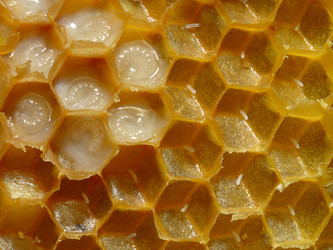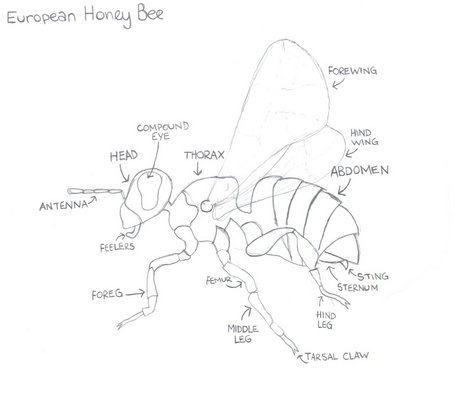European Honey Bee
Apis mellifera
Classification:
- Kingdom: Animalia
- Phylum: Arthropoda
- Class: Insecta
- Order: Hymenoptera
- Family: Apidae
- Genus: Apis
- Species: Apis mellifera


Honey bee pollinating a flower. © Norman Weston
The Queen Bee:
The queen Bee is the most valued bee in the whole hive. She is in charge of producing eggs. She can lay up to 2000 per day. The success of the reign of a queen bee is determined to a large degree by the number of times she mates with drones. A colony consists of a single queen and several thousand sterile worker bees. The queen's main job is to lay eggs. The more mating partners a queen Bee acquires, the longer-lived she tends to be. Queen bees usually mate early in their lives and store semen for future use. The lifespan of a long lived queen bee is typically 2-3 years.
Worker Bees:
The worker bees are sterile females who do a majority of the tasks in the hive. The worker bees have 32 chromosomes and have stingers, which the drones do not have. They have the responsibility of maturing honey, feeding the larvae and drones, grooming the queen, cleaning cells, producing wax, pollinating flowers and many more. The existence of the worker bee is vital to the maintenance of the hive and all the flowers requiring pollination.
Drones:
The main purpose of a male bee or drone is to mate with a queen bee. The drones develop from unfertilised eggs. That means they only have 16 chromosomes, in comparison to the worker bees, which have 32. The queen bee produces many pheromones, which tell the drones if she is a virgin. Drones have to travel to another hive to find a virgin queen. Drones are attracted to virgin queens by pheromones. The drones are confined to the hive except for cleansing and orientation flights on fine days. The drones do not help in any of the worker bees' duties like pollination. If there is a shortage of food in the hive, the drones are kicked out and eventually die. After summer ends, the drones are no longer required and are killed.
Offspring:
Most insects develop in 4 stages: embryo, larva, pupa, and imago. Bee embryos develop from eggs which the queen bee lays into cells. The eggs eventually hatch into larvae. Larvae are given brood food (brood referring to the growing stages of a bee), which is mostly royal jelly for the first 3 days and then they are fed nectar or diluted honey and pollen. The ones who will become queens will be soaked in royal jelly for 6 days. This will speed up growth and the queen's ovaries will be fully functional unlike those of the other females. Older larvae begin to spin a cocoon, and their older sisters cap the cell as they go into the pupa stage. These cells collectively are called "capped brood." They then go into a development period and come out as full-fledged bees!


Honeycomb of honey bees with eggs and larvae. The walls of the cells have been removed. The larvae (drones in this case) are about 3 or 4 days old. © Waugsberg.
Pheromones:
The pheromones are chemical messengers secreted by every type of bee, as their form of communication. Pheromones are produced as liquids and are transmitted by contact as a liquid or gas. The bee’s antenna and other body parts receive the chemical messages. Pheromones are grouped as releaser pheromones with short-term effects and primer pheromones with long-term effects. Releaser pheromones change the behaviour of the recipient. Releaser pheromones have a short-term effect and they trigger an almost immediate behavioural response from the receiving bee. Pheromones are not single chemicals, but rather a complex mixture of numerous chemicals in different percentages.
Pheromones have many functions such as:
- Create alarm. If a bee feels threatened, a pheromone is released and then it uses it’s stinger to puncture the enemy.
- Attract swarms. The queen bee uses this to attract drones to mate. Beekeepers also spray the pheromone to make the bees go to a certain place.
- Brood recognition. They help nurse bees to differentiate between larvae and pupae.
- Searching for nectar. Left by bees when they walk.
Products/ Importance of Ecosystem:
Honey:
Bees create honey through a complex procedure involving the gathering of nectar from plants. This honey is stored in honeycombs. In order to produce honey, the following is required: favourable weather conditions, strong queen bees, good hive conditions and good growing conditions of nectar producing plants.
Beeswax:
Worker bees that are between 12 and 17 days old are able to secrete wax from a series of glands located in their abdomens. To stimulate the production of the wax, a honeybee must cover itself with honey or sugary syrup and huddle with other bees to raise the temperature. Beeswax melts at 64 degrees Celsius, while the normal hive temperature is 37 degrees Celsius. The walls of the honeycomb are constructed from this wax.
Royal Jelly:
Royal jelly is a powerful, milky substance that can be used as a dietary supplement and fertility stimulant. The jelly is full of vitamin B and protein. It is made of digested pollen and honey or nectar mixed with chemicals secreted from a gland in the head of a nursing bee. Royal jelly turns an ordinary bee into a queen. The bee that eats the royal jelly as a larva becomes the queen bee. The queen bee grows 1 and a half times larger than a regular bee. The queen bee lives 40 times longer than a bee on a regular diet. Feeding royal jelly to other animals has yielded surprising results: the lifespan of pigs and roosters are shown to increase by up to 30%.
Pollination:
Agriculture is greatly dependant on honeybee pollination. Without the pollination, the world’s crops would be decreased by at least a third. A bee transports pollen around, depositing pollen into a blossom’s stigma when it lands on it. This allows crops to grow. Pollen grains are the male germ cells, which are produced by all flowering plants for fertilization and embryo formation. Bees carry pollen into the hive in a pollen basket. The pollen is used as food and a source of protein
Threats to the Species
In the United Kingdom, the European Honey Bee is threatened because of a varroa mite infestation. A varroa is a small, crablike organism, which infests the hive and rapidly devours the bees. The varroa mite is originally from Asia. The results of this infestation are disastrous for beekeepers. Furthermore, there has recently been a copious amount of dead honeybees in Eastern Europe as a result of pesticide-coated seeds.


Diagram of Honey Bee's Body. © Marina Noskova
Information on the Internet
- Life Cycle. Honey Bee British Bee Keeper's Association. Accessed 14 Sept. 2008
- Imrie, George. George Imrie's Pink Pages pdf. November 1999
- Honey Production Accessed 16 Sept. 2008
- Beeswax Accessed Accessed 16 Sept. 2008
- Facts about honeybees Back Yard Beekeepers. Back Yard Beekeepers Association. Accessed 16 Sept. 2008
- Watts, Isaac. Honey Bees Insecta Inspecta World. Accessed 16 Sept. 2008
- For Honey Bee Queens, Multiple Mating Makes Her Attractive To Workers Science Daily. 10 Oct. 2007. Accessed 16 Sept. 2008



 Go to quick links
Go to quick search
Go to navigation for this section of the ToL site
Go to detailed links for the ToL site
Go to quick links
Go to quick search
Go to navigation for this section of the ToL site
Go to detailed links for the ToL site